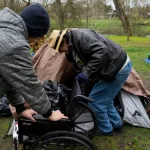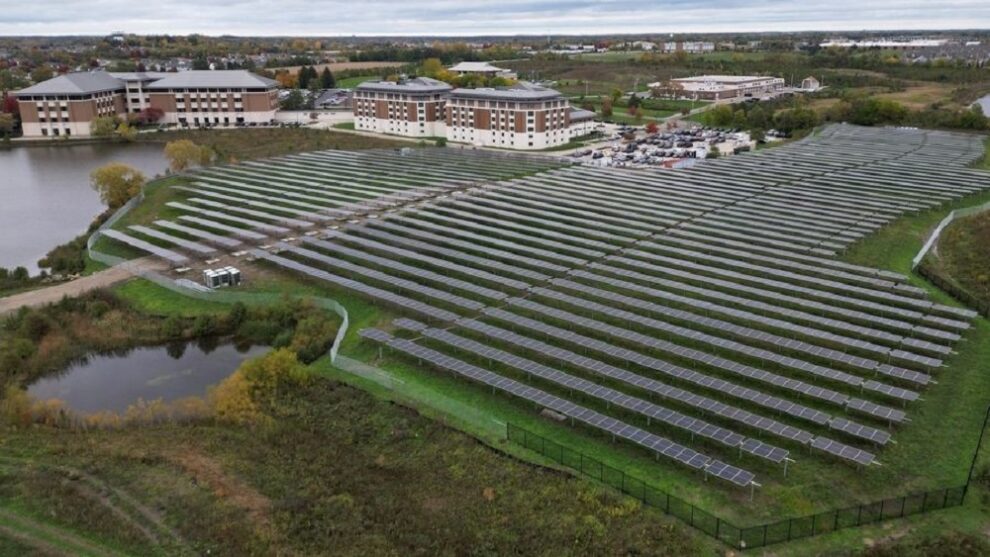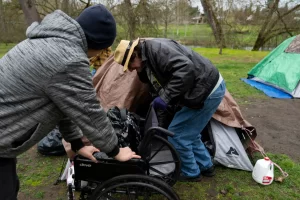Five Midwestern states — Illinois, Indiana, Michigan, Ohio and Wisconsin — are lagging behind other states when it comes to renewable energy, a new study from environmental organization The Nature Conservancy reports.
In Illinois, almost 20% of generated electricity comes from wind and solar as of March 2023. While that’s more than triple the amount generated a decade earlier, the state’s renewable portfolio pales in comparison to states such as Iowa, South Dakota and Oklahoma that are each generating more than 50% of their electricity from solar and wind.
The limited availability of local renewable energy could pose a challenge to large businesses: The study also found that, on average, 54% of large businesses and employers across the five Midwest states have ambitious greenhouse gas reduction targets.
“It’s no secret we need renewable energy to tackle climate change,” said Anna Dirkswager, The Nature Conservancy’s director of climate and energy in the Midwest. “We took a look at our largest employers because we know how important the commercial and industrial sectors are here in the Midwest. They’re our largest sectors.”
However, businesses can’t move forward if there are policies in place that discourage renewable energy, Dirkswager added. The Nature Conservancy’s study also looked at barriers to development, identifying local and state policies as well as land-use concerns.
“These challenges result in missed opportunities for job creation and emissions reduction,” according to a TNC news release. “They also hinder the ability to take advantage of tax incentives from the Inflation Reduction Act, which can cover up to 60-70% of the cost of a new solar or wind project.”
“It’s really important, I think, for everyday people to understand that these are commitments these companies are making and that we have an opportunity to allow them to make these commitments here — or elsewhere,” Dirkswager said.
Gov. J.B. Pritzker signed a bill earlier this year that took away county governments’ ability to preemptively limit or ban wind and solar power.
Though the majority of Americans believe climate change is happening, that doesn’t necessarily quell concerns about the potential negative effects of renewable energy developments on the environment and local communities. The Illinois law prompted conversations on whether it would only intensify such concerns.
To foster greater public acceptance of renewables — and help Midwestern businesses reach their clean energy goals — the study calls for “a holistic approach to renewable procurement and siting that avoids high-impacts on wildlife, habitat, people or communities.”
Solutions include siting practices that engage local communities early on in the development process.
“If you’re not presented with a project early on, where there’s engagement and you get a chance as a community member to say, ‘These are the things I want to see in this project, because these are the concerns I have,’ people are a little more cautious or maybe defensive about it,” Dirkswager said. “I think (developers) have got to do better about early and often engagement.”
The Nature Conservancy has a number of resources for energy planners, policymakers and businesses that are looking to fulfill net-zero goals while considering the “three C’s.”
“We know from peer-reviewed literature that projects that consider the three C’s — Community, Conservation and Climate — cost less and are more likely to happen,” Dirkswager said. “That’s extremely important from a project completion perspective, but from a climate change perspective as well, because we don’t have time to waste.”
The organization’s tools include a Power of Place report on responsible siting, a Power with Purpose case study that explores the “3C” framework, and a Site Renewables Right map, which displays key wildlife areas like bat roosts and whooping crane stopover sites for developers and local governments to consider when placing projects.
“The new set of tools is getting quite a bit of uptake. I really think businesses are hungry to do the right thing, and are desperately seeking guidance on how to do that,” Dirkswager said.
Source : Daily Herald





































